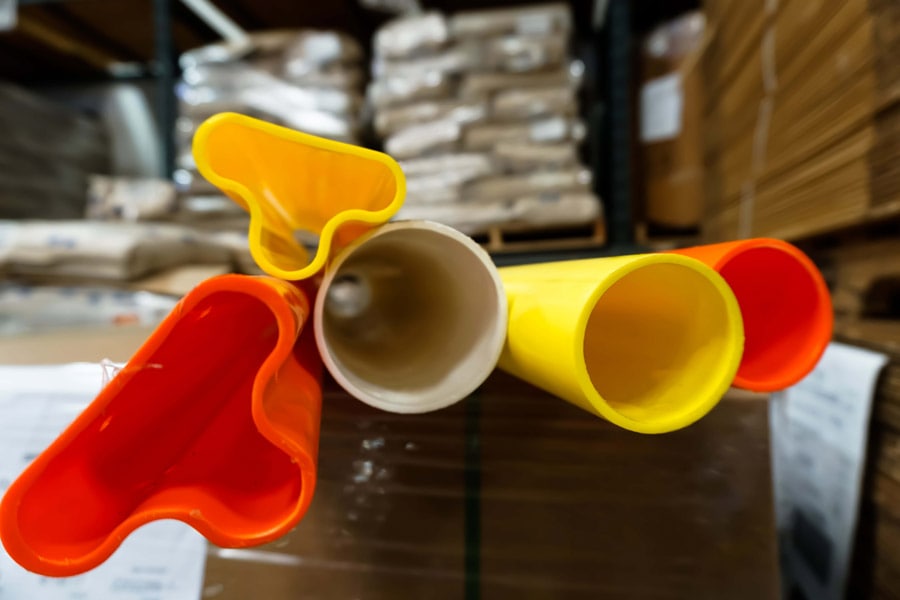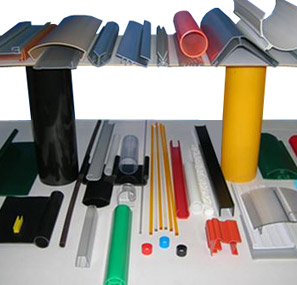Plastic extrusion is a widely used plastic manufacturing process. It is used to create components that feature continuous profiles and is commonly used with thermoplastics. Inline Plastics, Inc. has been providing custom plastic extrusion services for nearly a century, serving industries ranging from commercial to medical and more. This blog will discuss the plastic extrusion process, as well as its benefits and its most suitable applications.
The Plastic Extrusion Process
Plastic extrusion is a high-volume manufacturing process seen across many industries. Plastic extrusions are sometimes referred to as plastic sections or profiles and are produced using a piece of equipment known as an extruder. Extruders consist of four primary components:
- A vacuum or manual hopper: This holds the raw plastic material and feeds it into the machine.
- A barrel: The long section includes a screw-like mechanism to push plastic through the barrel.
- External heaters: These are necessary to ensure the desired internal barrel temperatures are maintained.
- A die: This forms the profile of the plastic component being manufactured.
The Extrusion Process
The term extrusion implies a pushing action. When plastic components are produced using this process, raw melted plastic is pushed into a die to achieve a predetermined shape. There are several techniques involved in the extrusion process, and they can be broken down into three steps.
Stage 1: There are several materials used to produce plastic extrusions, including the raw plastic materials themselves, colorants, and additional additives. In the first stage, raw plastic compounds are mixed with any desired colorants and additives and fed into the extruder.
Stage 2: The second step in this process is to melt the ingredients together. Strategically positioned heat zones along the barrel of the extruder gradually melt plastic material in a way that ensures it doesn’t overheat or degrade the polymer. Heat is then generated from the friction of the rotating screw that pushes the molten plastic through the barrel, where it emerges and is filtered to ensure the final product is free from any contaminants.
Stage 3: After the plastic and other materials have been melted, combined, and filtered, the final stage in the process can begin: shaping and cooling. The molten material is forced into a die that creates the final shape of the component. The component’s profile is held in shape by formers as it proceeds through water baths to facilitate the cooling process. After the component has cooled, it is hardened and the extrusion process is complete.
Plastic Extrusion Benefits & Applications
Plastic extrusion is a popular option due to its ability to produce highly customized components. Some key benefits of this process also include:
- Low cost: In comparison to other molding processes, plastic extrusion is more efficient and offers reduced costs. During this process, waste is minimized, as thermoplastic waste can be repeatedly re-melted and reused instead of discarded. Additionally, plastic extrusion machines provide 24-hour manufacturing capabilities, operating continuously and reducing the likelihood of inventory shortage.
- Increased flexibility: Providing that the components feature a consistent cross-section, extrusion molding delivers significant design flexibility. Highly complex shapes are easily produced through this technique and, by making only minor adjustments, a diverse selection of components can be produced, including plastic sheeting and products that feature mixed plastic attributes.
- Post-extrusion alterations: Since plastic materials remain hot and malleable for some time after they are removed from the extruder, post-extrusion manipulations are possible. Rollers, shoes, and dies can be used to alter the shape of the plastic if needed.
Extruded plastic components have many applications, including:
Piping and tubing: Typically made from thermoplastics or polyvinyl chloride (PVC), piping and tubing are common extruded plastic components due to their simple cylindrical profile. One example of extruded tubing is exterior gutters.
Wire insulation: Many thermoplastic materials provide excellent thermal stability and electrical insulation properties. Due to this fact, extruded wire and cable insulation and jacketing is a common application for extruded materials. Typically, fluoropolymers are used for this purpose.
Window and door profiles: The continuous profile and length of plastic door and window frames make them ideally suited to the extrusion process. PVC is a popular material for these components as well as other household-related fittings.
Blinds: Window shades and blinds frequently consist of identical slats that are easily extruded using thermoplastics. Their profile typically features one rounded side and a short length which is simple to produce. Polystyrene is the most commonly used material for manufacturing faux wooden Venetian blinds.
Weatherstripping: Products such as draft excluders and other similar weatherstripping products are commonly produced using plastic extrusion processes due to their profiles. Rubber is a frequent material for these products.
Windshield wipers and squeegees: Automotive windshield wipers are typically extruded using a variety of rubber materials or synthetic and natural rubber co-extrusion. Manual squeegee blades feature a similar profile and are another common application.
Plastic Extrusion Services From Inline Plastics
Inline Plastics, Inc. offers competitively priced custom plastic extrusions using over 20 different thermoplastics. We perform secondary operations and deburring during the actual extrusion process, allowing us to eliminate the high costs typically associated with these secondary processes. Our turnaround time for simple dies is as little as one to two days. Learn more about our services by contacting us today.

